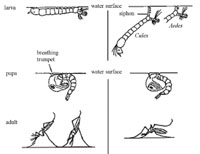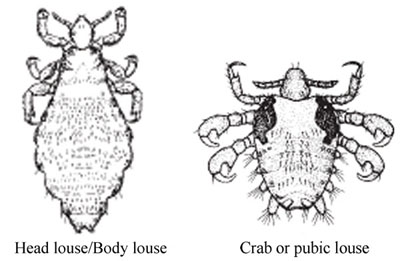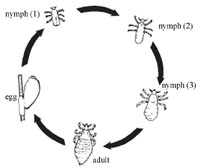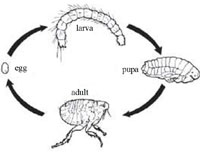Common insect vectors
Take a look around your household environment: the kitchen, wastes, walls and clothes. What insect vectors might you find? You may want to ask someone else as well.
You may have seen houseflies and mosquitoes. Fleas and lice may also be present, although less easy to see.
Housefly
We are all familiar with this small creature that disturbs us in and around the household and in workplaces. The female lays 200–250 eggs at a time on organic matter. The organic matter could be human faeces, decaying animal and vegetable matter, fresh food or dung. Eggs are white and about 1 mm long. Within 8 to 48 hours the eggs hatch into tiny larvae. These maggots feed voraciously and pass through the three larval stages rapidly; then after four to eight days they pupate. The pupa gradually hardens and changes colour from yellow through red to brown and finally to black. This pupal stage takes three to five days under optimum conditions. The adult fly is attracted to breeding sites that will provide food and warmth for larvae.
You need to know that there are many different types of fly. Flies that are usually seen around a latrine are different from the common housefly in size and colour. However, they share similar breeding and eating behaviour.
Mosquitoes
There are three main mosquito groups: Anopheles, Culex and Aedes. Anopheles mosquitoes breed in stagnant, relatively clean water bodies; Culex breed in polluted water; and Aedes like relatively clean water. Eggs are laid in a group (150–200 for Anopheles, 200–500 for Culex) on the water surface and hatch into larvae within a few hours. The larvae breathe oxygen from the air and stay at the surface of the water. They feed on organic matter and microorganisms in the water or on the surface. The larva changes into a pupa which can propel itself using paddles at the bottom of the abdomen. The adult mosquito emerges from the pupa on to the surface of the water and then flies away. The duration of the cycle is about 10–14 days depending on the water temperature. The mosquito life cycle is shown in Figure 6.3.

Only female mosquitoes bite and suck blood; the males feed on the nectar of flowering plants. Females are attracted to a host by heat and exhaled carbon dioxide. A blood meal is required before viable eggs can be laid. During feeding on humans, a small amount of anticoagulant saliva will be injected into the host to prevent the blood from clotting. The malaria infectious agent is introduced into the bite site while feeding on blood.
Different species of mosquito carry different diseases. Malaria is transmitted by Anopheles mosquitoes; yellow fever and dengue fever mostly by Aedes. Identification of mosquitoes is difficult without training but breeding behaviour and physical markers can be used to identify the main groups (Figure 6.4).

What do you notice are the differences between the two types of mosquito shown in Figure 6.4?
Anopheles adults rest at an angle of about 45 degrees to the surface they are standing on, while adult Aedes and Culex rest with the body parallel to the surface. The opposite is true for the larval resting position in relation to the water level. Anopheles larvae lie horizontally at the water surface but Culex and Aedes hang at an angle below the surface.
Lice
There are three types of human louse: the head louse, body louse and pubic louse (see Figure 6.5). All of them are wingless biting insects and live by sucking human blood. They differ in colour and, as their names suggest, in the places on the human body where they are typically found. Head lice are particularly common in children. Being bitten by lice is painful, disturbing and embarrassing, and may cause an allergic reaction.

Head lice eggs are laid at the base of the hair and then hatch, leaving the pale-coloured egg casing, known as a ‘nit', on the hair (Figure 6.6). The larvae feed on blood until they reach sexual maturity. The life cycle takes about 15 days with laying of about 300–350 eggs at a time. Body lice live in the clothing of the host, especially hiding in the seams. They move towards to the skin of the host to feed. Pubic lice favour the coarser body hair found in the pubic area and armpits.

Bedbugs
Bedbugs are notorious night-biting insects. They are typically found in houses with poor housing sanitation and are abundant in poor urban and rural areas. They irritate the person while sleeping and disturb the sleep of children. Bedbugs love to hide around the bed and inside crevices of the wall during the daytime, and then become active at night.
Female bedbugs deposit three to eight eggs at a time. A total of 300–500 eggs can be produced by a single bug in a lifetime. They are often deposited in clusters and in cracks, crevices or attached to rough surfaces with a sticky glue-like substance. Eggs typically hatch in a week to 12 days (Figure 6.7). There are five larval stages for bedbugs to reach maturity, which usually takes about 32–48 days. Adult bedbugs can survive for up to seven months without blood and have been known to live in empty buildings for up to one year.

Fleas
Adult fleas are ectoparasites of warm-blooded animals. There are human, rat, cat, bird and dog fleas, but they can all readily feed on other species in the absence of their primary host.
The prefix ecto- means ‘on the outside', as opposed to endo- which means ‘on the inside'.
The human flea infests houses with poor sanitation, especially those with a warm, earth floor and dark places. The adults live by biting and sucking blood. The bite is painful, disturbing and irritating. The fleas may be seen on the host animal or on bedding or clothing. More commonly, humans will be alerted to the presence of fleas from the itching that results from being bitten. The bites of cat fleas tend to be confined to the lower legs and ankles, whereas the bites of human fleas tend to be concentrated around the waist and abdomen.
Females require a fresh blood meal in order to produce eggs. Females lay eight to ten eggs in dark places. The eggs hatch within two days into larvae which feed on organic matter and develop into pupae. The life cycle takes three to four weeks; it is shown in Figure 6.8.
